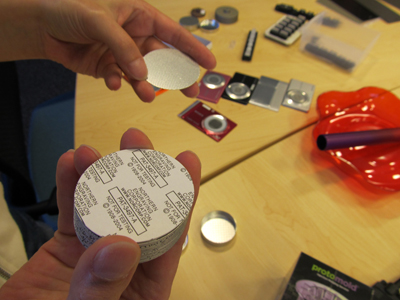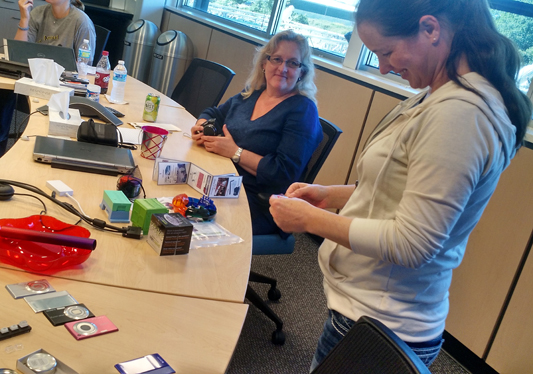Project managers and members of marketing exploring product samples
“Design is more than the aesthetics and artifacts associated with products; it’s a strategic function that focuses on what people want and need and dream of, then crafts experiences across the full brand ecosystem that are meaningful and relevant for customers.”
-Mauro Porcini, Chief Design Officer of PepsiCo
“Failing to involve designers in user research would be a waste of talent we already have.”
During the summer of 2015 I had the privilege of leading a discussion about the role of design at Electronic Theatre Controls (or ETC). ETC is a major player in the lighting industry and make products ranging from spotlights to architectural control systems.
The above quote from Mr. Porcini set the tone for our discussion and activity over the course of the next several hours and one catered meal of tacos. It is a timely and relevant statement for both ETC and global industry in general. It served to helped us frame our need to better integrate the principles of industrial design into our products.
During that time we discussed the role and benefits of design in the product development process. We also explored what we liked and didn’t like about a variety of manufactured items. It was a collaborative and hands-on experience that allowed us to consider the many qualities that play a part in a product’s development and success.
However, it was by no means a 'design sermon' intended to elevate the practice and principals of design above other roles and considerations that play a part in the concept to production pipeline. Rather it was an open and frank discussion about the hurdles faced by all parties. In this way we could all begin to form a better picture of the role each team was equipped to play in the process.
"An open and frank discussion about the hurdles faced by all parties."
Concept Development
In our discussion of design in product development several considerations stood out as key to a successful process:
- What is the core issue of the problem?
- Have we identified ALL of our users and advocates?
- Begin development of concepts early.
- Include design requirements (aesthetics, user experience) in the MRD (Manufacturing Requirements Document).
- Create rough prototypes earlier and more frequently to determine ergonomics, scale, and appearance.
- Involve other ETC creatives at the appropriate times to help ‘tell the story’ of the product.
It was insightful to explore areas of opportunity for ETC that had previously not been recognized. Following through with these considerations will help the company achieve some incremental improvement and score the ‘quick wins’ that will help ETC demonstrate the benefits of involving design at the right time.
exploration activity
After discussing the role of design we all took on the role of the design critic.
Laid out across the table was a collection of manufactured items ranging in shape , size, color, material, and finish. We spent some time browsing through the items and casually discussing them before picking our favorites.
After making our selections participants took turns discussing their findings based on the following criteria:
"What do you like, and why do you like it?"
- Inspiration
- Appearance / Affordances
- Function / Environment of Use
- Material
- Manufacturing Method
- Product Lifecycle
- What's Missing?
conclusion
Design holds great potential for ETC products and brand image. The talented people involved in that process are primed to coordinate their efforts and develop their own creative language. It's likely they will even have a little fun along the way!
*Some crowd favorites: The Houdini wine stopper (left) proves simple products don't have to keep a simple appearance. And the example kit from Protomold (right) shows how technical information can be demonstrated in an engaging fashion.
Houdini Deluxe wine stopper
Material, process, and finish examples from Protomold









